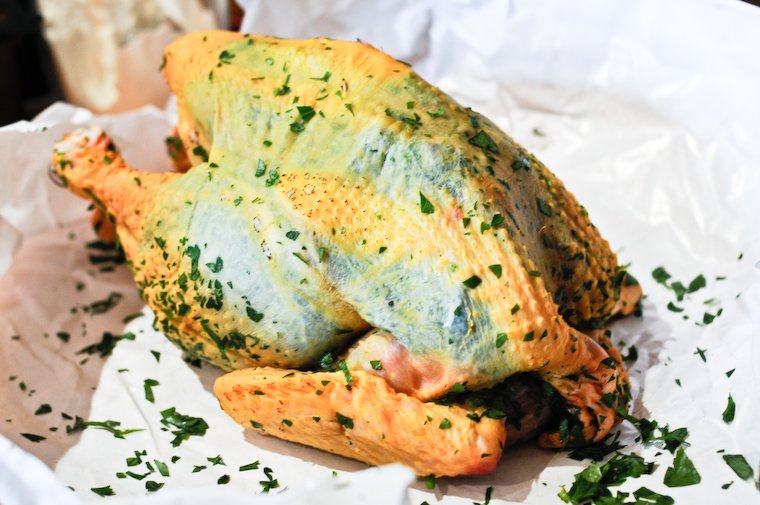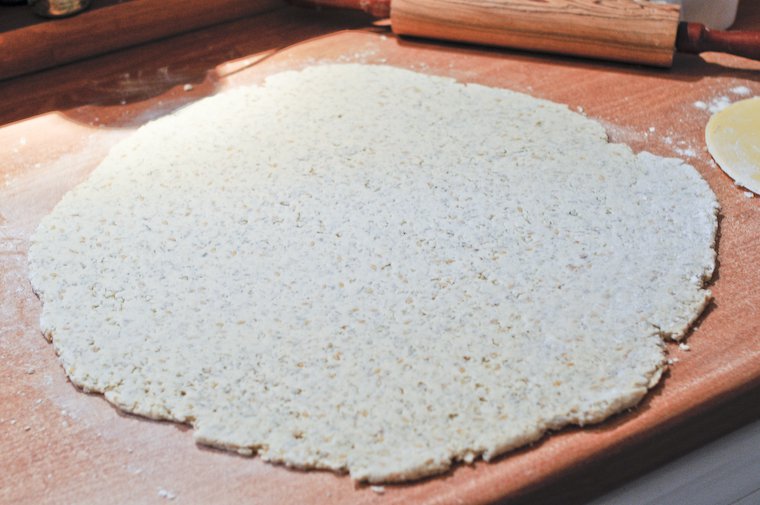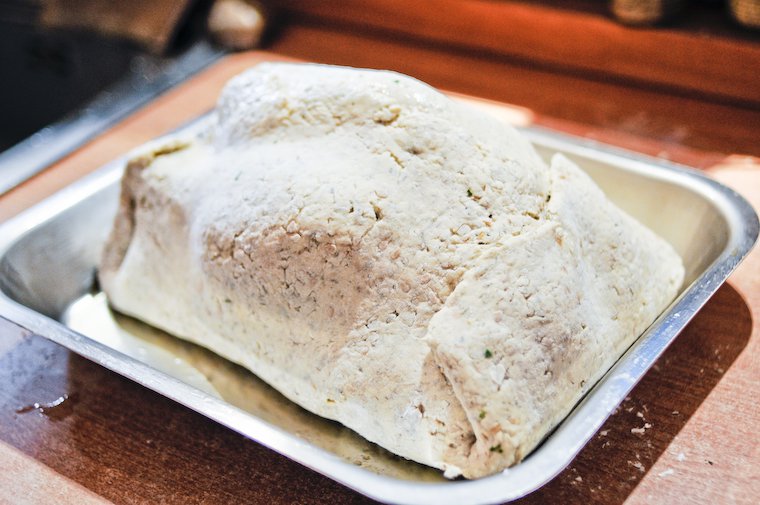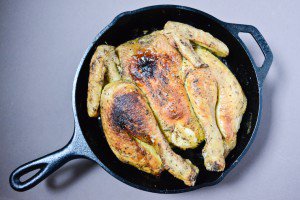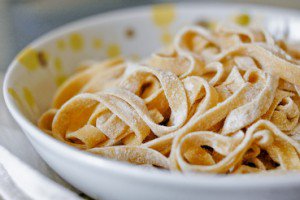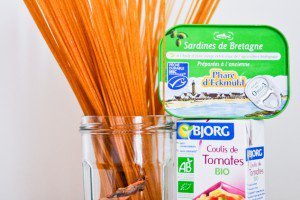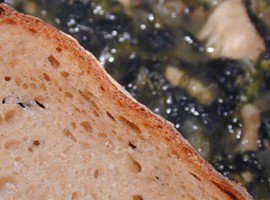I was recently interviewed for the website of French publisher Larousse, and one of the questions was, “What is it that appeals to you in a recipe?” I replied that I was drawn to recipes that a) were simple, b) featured flavor pairings that were sure-footed (and optionally unusual) and c) gave me the opportunity to learn a new technique.
All three qualities are united in today’s recipe, originally found in Yves Camdeborde’s fantastic little book Un Dimanche en famille, which I’ve written about in glowing terms before. It is a recipe for salt-crusted chicken, a chicken that is wrapped in a heavily salted dough before it’s baked in the oven.
The all-important wow factor is at play here: breaking the salt crust open to reveal the golden chicken nested inside never fails to elicit a few gasps and squeals in the audience.
The salt crust thing is a classic technique I had long ambitioned to try — I’ve even amassed a handful of almost identical recipes for it in my clippings file over the years — but it had always made me feel two parts incredulous and one part intimidated, so I’d never acted on that ambition.
Camdeborde’s recipe (which I found reprinted here, if you want to take a look) must have shown up at just the right time in my maturation process as a cook: it was laid out in a way that seemed very straightforward, and if his take on sablés was anything to go by, he was a trustworthy recipe writer.
Maxence and I hardly ever eat meat or fish anymore when it’s just the two of us, but I still cook some on occasion when we have company, so I first gave the salt-crusted chicken a try last spring, when our friends Braden and Laura came over for dinner. It was so successful, the chicken so flavorsome and so perfectly cooked, that I’ve made it half a dozen times since then, which is a freakishly high rate of repetition for me.
The brilliance of this recipe is so manifold that I need bullet points:
– First, Camdeborde has you slip chopped parsley underneath the skin of the chicken, and this definitely improves both the taste and the looks of the beast. (Plus, people wonder how you got the herbs in there, just as they wonder about those boats-in-a-bottle.)
I’m sure some cooks will go faint at the idea that they have to slip their hand between the skin and the flesh of the raw chicken to achieve that effect, and certainly you can skip that part if you prefer, but I’ve never been squeamish about handling meat, so it doesn’t bother me one bit — it’s actually kind of fun to do.
– Second, baking the chicken in a salt crust allows it to cook in its own juices without drying, and this makes for a remarkably tender and succulent meat — even the breasts are uncommonly juicy.
– Because the crust is porous, rather than airtight like a lidded pot would be, the skin bakes to a lightly crisp and appetizing golden hue.
– Since there is no risk of the meat drying out, it also allows for a certain flexibility in the cooking time, and total serenity if your guests happen to be stuck in the metro.
– It makes zero mess in the oven, and as anyone who’s ever roasted a chicken is sorely aware, that’s a definite plus.
– And finally, there’s the all-important wow factor: when you pull the dish out of the oven, you get to break the salt crust open to reveal the golden chicken nested inside, and this never fails to elicit a few gasps and squeals in the audience.
Now that I’ve made this recipe a number of times, it has gradually evolved from the printed version with these few adjustments: I throw a few garlic cloves inside the chicken for extra flavor; I oil the baking dish to prevent the salt crust from sticking to it; it seemed wasteful and inconvenient to use egg whites as a binder in the salt crust when it only ends up in the trash, so I use ground flax seeds gelled in water instead, which is a well-known vegan substitute for eggs; even though Camdeborde says it’s unnecessary, I truss the chicken before wrapping it in the salt dough, so the tips of the thighs and wings won’t pierce through it; I bake the chicken for about twice as long as he recommends, for fall-off-the-bone tender meat.
I am bracing myself for the clamor of people who want a picture of the finished product, and I understand the impulse, but I’ve always served this to friends, and when the chicken is ready all I want is for Maxence to carve it and for us all to sit down and eat while it’s warm — I’m sure you can relate — so it’s never a good time to stop and take a shot. I may try harder next time, but for now, I’m going to ask you to use your imagination, or better yet, try the recipe in your own kitchen. You won’t be sorry.

Have you tried this? Share your pics on Instagram!
Please tag your pictures with #cnzrecipes. I'll share my favorites!
Ingredients
- one chicken, organic and/or from a source you trust, about 2 kilos (4.4 pounds)
- 1 medium bunch flat-leaf parsley, roughly chopped
- 3 cloves garlic, crushed with the flat of a knife blade
- 500 grams (17 2/3 ounces, about 3 3/4 cups) all-purpose flour
- 300 grams (10 1/2 ounces, about 1 1/3 cups) coarse salt
- 3 tablespoons thyme, fresh if available, dried otherwise (other dried herbs may be substituted, such as rosemary or oregano)
- 6 tablespoons ground flax seeds, or 160 grams (5 2/3 ounces) egg whites (from 4 to 5 large eggs)
Instructions
- Lightly oil a baking dish big enough to hold the chicken comfortably. Set aside.
- If you're using flax seeds rather than egg whites, place them in a bowl with 100 ml (6 tablespoons + 2 teaspoons) fresh water, and set aside for about 15 minutes, until the water is completely absorbed and the mixture is gelled.
- Place the chicken on a work surface, on its back, with the neck side facing you. Slip your hand under the skin, starting at the base of the neck, and work gently to get your hand further in, lifting the skin from the flesh over each breast, and down over each thigh, without tearing the skin. Once the skin is loosened, slip in the chopped parsley, pushing it underneath the skin to cover the breasts and the thighs as evenly as you can.
- Place the garlic inside the cavity of the chicken. Using a piece of chicken string, truss the chicken as demonstrated in Peter Hertzmann's Preparing for roasting video at minute 2:30. Set aside.
- In a large mixing bowl, combine the flour with the salt and thyme. Add the soaked ground flax seeds or the egg whites, and 160 ml (2/3 cup) fresh water, and stir with a wooden spoon or a dough whisk until the liquids are absorbed. Turn out onto a clean work surface, and knead briefly until the dough comes together; it should be supple and pleasant to work with, not sticky or crumbly. Add a little water or flour as needed to adjust the consistency.
- Flour your work surface well, and roll out the salt dough into a circle large enough to wrap the chicken in it (I shoot for a diameter of about 50 cm or 20").
- Place the chicken in the middle of the circle and fold opposite flaps of the dough over the chicken to wrap it entirely. Press gently to seal; if it looks like the dough might not stay put, brush the seams with a pastry brush dipped lightly in water.
- Lift the whole thing carefully but with determination, and transfer it to the prepared baking dish. Place in the fridge until ready to bake -- you can leave it in for a few hours or overnight. If the salt crust cracks slightly here or there, don't worry about it; it doesn't need to be 100% airtight.
- Remove the chicken from the fridge and preheat the oven to 200°C (400°F). Insert the dish in the oven and leave it in for 1 1/2 hours (a little more won't hurt if the guests are late; just turn off the oven and leave the chicken inside).
- Remove the dish from the oven, and break the salt crust open with a meat mallet or the handle of a chef knife. Once fractured, the crust can be simply pulled open with your oven-mitt-clad hands (it's fun).
- Lift the chicken from the open crust, transfer it to a cutting board, and carve it. Discard the crust. Serve the chicken with the cooking juices, perfect roasted potatoes, and a green salad.
